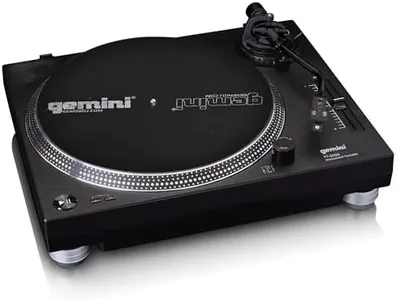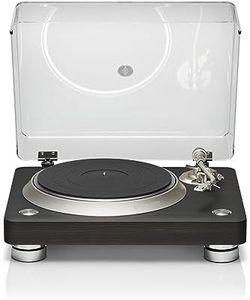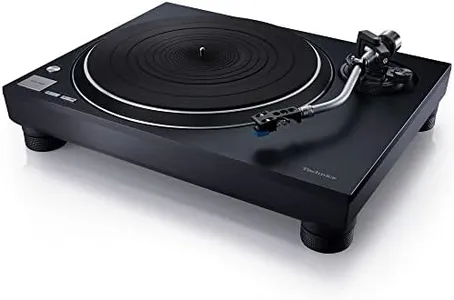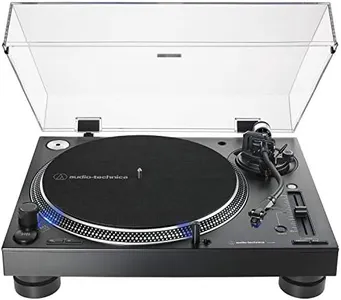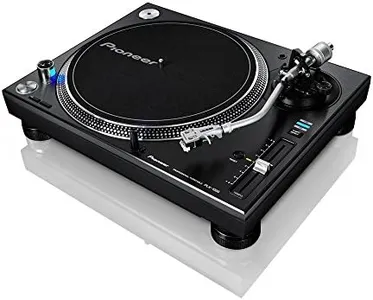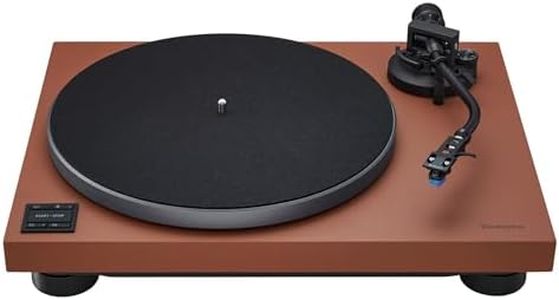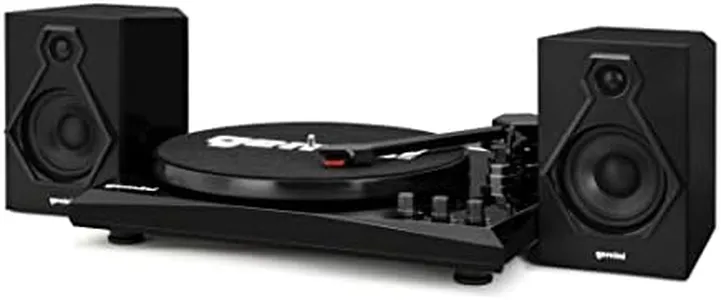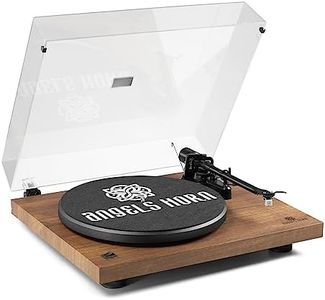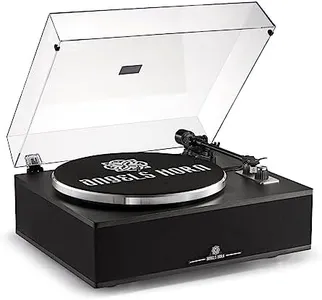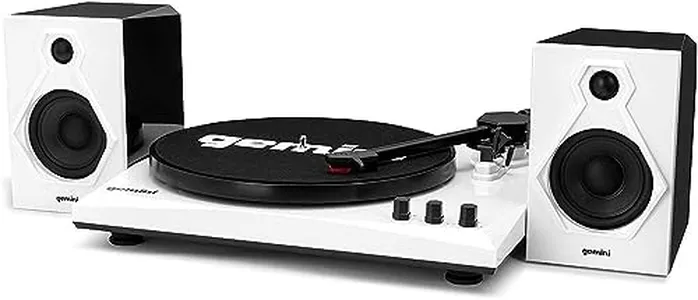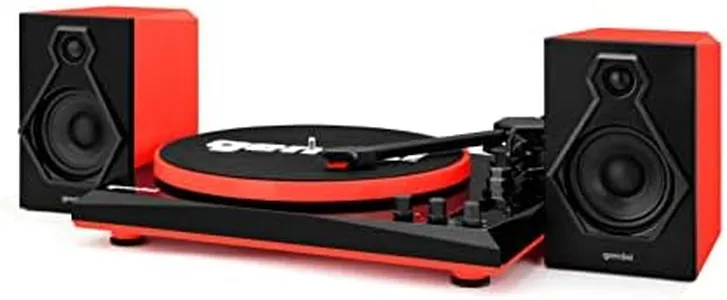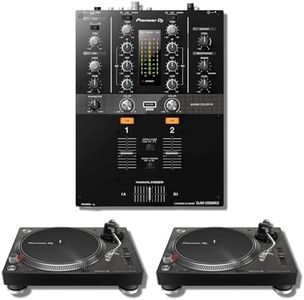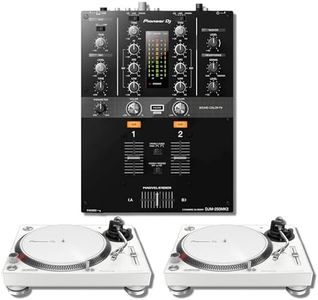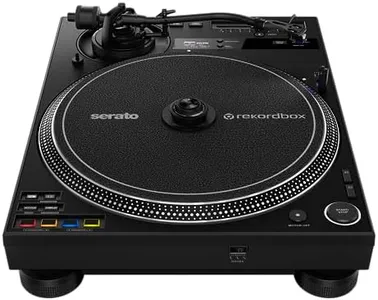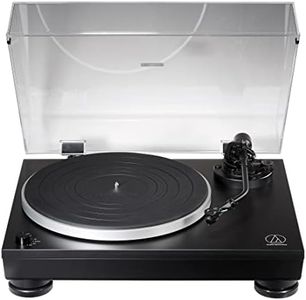10 Best Direct Drive Turntables 2025 in the United States
Our technology thoroughly searches through the online shopping world, reviewing hundreds of sites. We then process and analyze this information, updating in real-time to bring you the latest top-rated products. This way, you always get the best and most current options available.

Our Top Picks
Winner
Denon DP-3000NE Fully Automatic Analog Turntable & Vinyl Record Player with Built-in Phono Equalizer | Turntables for Vinyl Records | Unique S-Shaped Tonearm Design | Hologram Vibration Analysis
Most important from
573 reviews
The Denon DP-3000NE Record Player is a modern turntable designed to breathe new life into your vinyl collection. With its direct-drive motor, the player ensures a steady and reliable performance across 33-1/3, 45, and 78 RPM records, making it quite versatile. The standout feature here is the special S-shaped tonearm, which aims to reduce vibration for a more precise sound, and its compatibility with both MM and MC cartridges offers flexibility in your choice of stylus.
The matte dark ebony wood veneer finish provides a timeless look that would be a stylish addition to any room. The build quality is solid, featuring sound-insulated feet to help dampen any unwanted noise, enhancing the listening experience. However, the player weighs 40.78 pounds, making it less portable compared to lighter models. While its weight adds to its stability, it might not be the most convenient option if you plan to move it frequently.
Another point to consider is its relatively higher price point, which might not be the best fit for those on a budget. On the plus side, the package includes useful accessories like an RCA cable, 45RPM adapter, and a dummy headshell for calibration, making setup straightforward for users. For those looking for a high-quality listening experience and have the budget for it, the Denon DP-3000NE is a strong contender in the direct-drive turntable market.
Most important from
573 reviews
Technics Turntable, Premium Class HiFi Record Player with Coreless Direct, Stable Playback, Audiophile-Grade Cartridge and Auto-Lift Tonearm, Dustcover Included – SL-100C, Black (SL-100C-K)
Most important from
132 reviews
The Technics SL-100C direct-drive turntable brings a touch of audiophile quality to your vinyl listening experience. One of its standout features is the coreless direct drive motor, which ensures smooth and stable playback, minimizing disruptions in sound. This is great for anyone looking to enjoy their records without the typical noise or vibration issues that can occur with less advanced models. The high-sensitivity aluminum S-shape tonearm is designed for optimal tracking, making it capable of accurately reading the grooves of your records, which is essential for preserving sound quality.
One notable advantage of the SL-100C is its pre-installed Audio-Technica cartridge, which provides excellent audio fidelity right out of the box. This means less hassle for users who might not want to deal with the complexities of setting up a new cartridge themselves. Additionally, the tonearm height can easily be adjusted, allowing for future upgrades if desired.
A unique feature is the Auto-Lifter, which automatically raises the tonearm at the end of a record, helping to prevent unnecessary wear on both the stylus and your vinyl. This thoughtful addition enhances the longevity of your records, a significant plus for any vinyl collector. While the SL-100C is visually appealing with its minimalist design, it is relatively heavy at 21.8 pounds, which might make it less portable. Also, despite its advanced features, it might feel a bit simplified for advanced users looking for more manual adjustments. Some might find the price point a bit high compared to entry-level models, but the quality justifies the investment for serious audiophiles. The Technics SL-100C is an excellent choice for those who appreciate quality sound and ease of use in a direct-drive turntable, catering well to both beginners and more experienced users looking for a reliable and stylish player for their vinyl collection.
Most important from
132 reviews
Audio-Technica AT-LP140XP-BK Direct-Drive Professional DJ Turntable, Hi-Fi, Fully Manual, 3 Speed, High Torque Motor
Most important from
402 reviews
The Audio-Technica AT-LP140XP-BK is a robust direct-drive turntable designed for professional DJs and Hi-Fi enthusiasts. It features a high-torque motor, which ensures quick and stable start-ups, making it reliable for performances. The platter is crafted from die-cast aluminum, providing durability and reducing unwanted vibrations, which helps in achieving clearer sound quality. This turntable also includes a professional tonearm that offers precise tracking, essential for accurate sound reproduction.
The included AT-XP3 cartridge and stylus are designed for high fidelity and durable playback, which is a significant advantage for frequent use. Additionally, it supports three speeds (33-1/3, 45, and 78 RPM), making it versatile for playing various record types. One of its standout features is the variable pitch control with reverse and quartz speed lock, which allows DJs to manipulate the playback speed with ease and precision. The plug-type target light is a thoughtful addition for cueing in low-light environments, beneficial during live performances.
However, the turntable is manual, meaning users need to move the tonearm by hand, which might not be convenient for everyone. At a weight of 22 pounds, it's quite hefty, so portability could be an issue if you need to frequently move it around. Additionally, it is wired only, which means it lacks modern wireless connectivity options. This turntable is best suited for professional DJs or audiophiles who prioritize sound quality and durability over portability and convenience.
Most important from
402 reviews
Buying Guide for the Best Direct Drive Turntables
When choosing a direct-drive turntable, it's important to consider several key specifications to ensure you get the best fit for your needs. Direct-drive turntables are known for their durability, quick start-up times, and consistent speed, making them a popular choice for DJs and audiophiles alike. Understanding the key specs will help you make an informed decision and find a turntable that suits your listening or performance requirements.FAQ
Most Popular Categories Right Now
